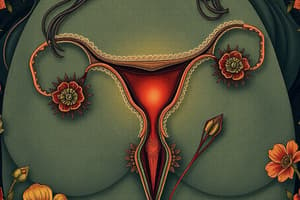Podcast
Questions and Answers
What is ovulation?
What is ovulation?
Ovulation is the monthly release of one or more mature eggs from a woman's ovaries.
What hormones are involved in the process of ovulation?
What hormones are involved in the process of ovulation?
Gonadotropin-releasing hormone (GnRH), luteinizing hormone (LH), and follicle-stimulating hormone (FSH) are involved in ovulation.
Where does fertilization typically occur in the female reproductive system?
Where does fertilization typically occur in the female reproductive system?
Fertilization typically occurs in the fallopian tubes if the egg meets a viable sperm cell.
What is spermatogenesis?
What is spermatogenesis?
How long does the process of spermatogenesis typically take to complete?
How long does the process of spermatogenesis typically take to complete?
What triggers the final maturation and release of the egg during ovulation?
What triggers the final maturation and release of the egg during ovulation?
What are the two hormones essential for spermatogenesis?
What are the two hormones essential for spermatogenesis?
Which cells support the development of spermatogenic cells and maintain the blood-testis barrier?
Which cells support the development of spermatogenic cells and maintain the blood-testis barrier?
What is the function of Leydig cells in spermatogenesis?
What is the function of Leydig cells in spermatogenesis?
What are the three main requirements for sperm cells to successfully fertilize an egg?
What are the three main requirements for sperm cells to successfully fertilize an egg?
What aids the journey of sperm cells through the female reproductive tract?
What aids the journey of sperm cells through the female reproductive tract?
What process occurs when sperm cells encounter a mature egg?
What process occurs when sperm cells encounter a mature egg?
Flashcards are hidden until you start studying
Study Notes
Fertilization: A Journey of Sperm and Egg
Fertilization is the union of a sperm cell (spermatozoon) from the male and an egg cell (oocyte) from the female to create a single cell—the zygote—which eventually develops into a human being. This lifelong process begins with ovulation and sperm production in the body.
Ovulation: The Female's Release of Eggs
Ovulation is the monthly release of one or more mature eggs from a woman's ovaries, usually occurring around day 14 of the menstrual cycle. The egg is then transported through the fallopian tubes, where fertilization occurs if the egg meets a viable sperm cell.
The process of ovulation is a complex interplay of hormones. At the onset of a woman's menstrual cycle, the hypothalamus releases gonadotropin-releasing hormone (GnRH), which signals the pituitary gland to secrete luteinizing hormone (LH) and follicle-stimulating hormone (FSH). FSH stimulates the growth of several follicles in the ovaries, and one eventually matures to release an egg. Rising estrogen levels and a surge of LH in the mid-cycle trigger the final maturation and release of the egg.
Sperm Production: The Male's Fertility Factories
Sperm production, known as spermatogenesis, takes place in the male testes. A single testicle contains millions of sperm-producing cells, called spermatogonia, that develop into sperm cells through a series of cell divisions and maturation stages. This process typically takes about 74 days to complete.
Essential for spermatogenesis are:
- Hormonal regulation: FSH and testosterone, produced by the pituitary gland and testes, respectively, stimulate spermatogenesis.
- Spermatogenic cells: These cells are responsible for the production and maturation of spermatozoa.
- Sertoli cells: These cells support the development of spermatogenic cells and maintain the blood-testis barrier, ensuring a stable environment for sperm production.
- Leydig cells: These cells in the interstitial tissue produce testosterone, a hormone that stimulates spermatogenesis.
The Journey of Sperm and Egg
To complete fertilization, sperm cells must travel from the male reproductive system to the female reproductive system. After ejaculation, sperm cells swim through the female reproductive tract, a journey that can take several days. To successfully fertilize an egg, sperm cells must:
- Survive the acidic environment of the vagina and cervix.
- Navigate the uterus and reach the fallopian tubes.
- Swim through the fallopian tubes to encounter the mature egg.
The journey of sperm cells is aided by several factors, most notably the whip-like tail of the sperm cell, which propels the cell through the female reproductive tract. Once sperm cells reach the egg, fertilization occurs, and the zygote begins its journey to implantation and eventually birth.
Understanding ovulation and sperm production is an essential step in learning about fertility and fertilization. By investigating these processes, we uncover the complex journey of a sperm cell and an egg, which ultimately result in the creation of new life.
Studying That Suits You
Use AI to generate personalized quizzes and flashcards to suit your learning preferences.




